Best sitting Position to help Baby find a good Position in the Womb
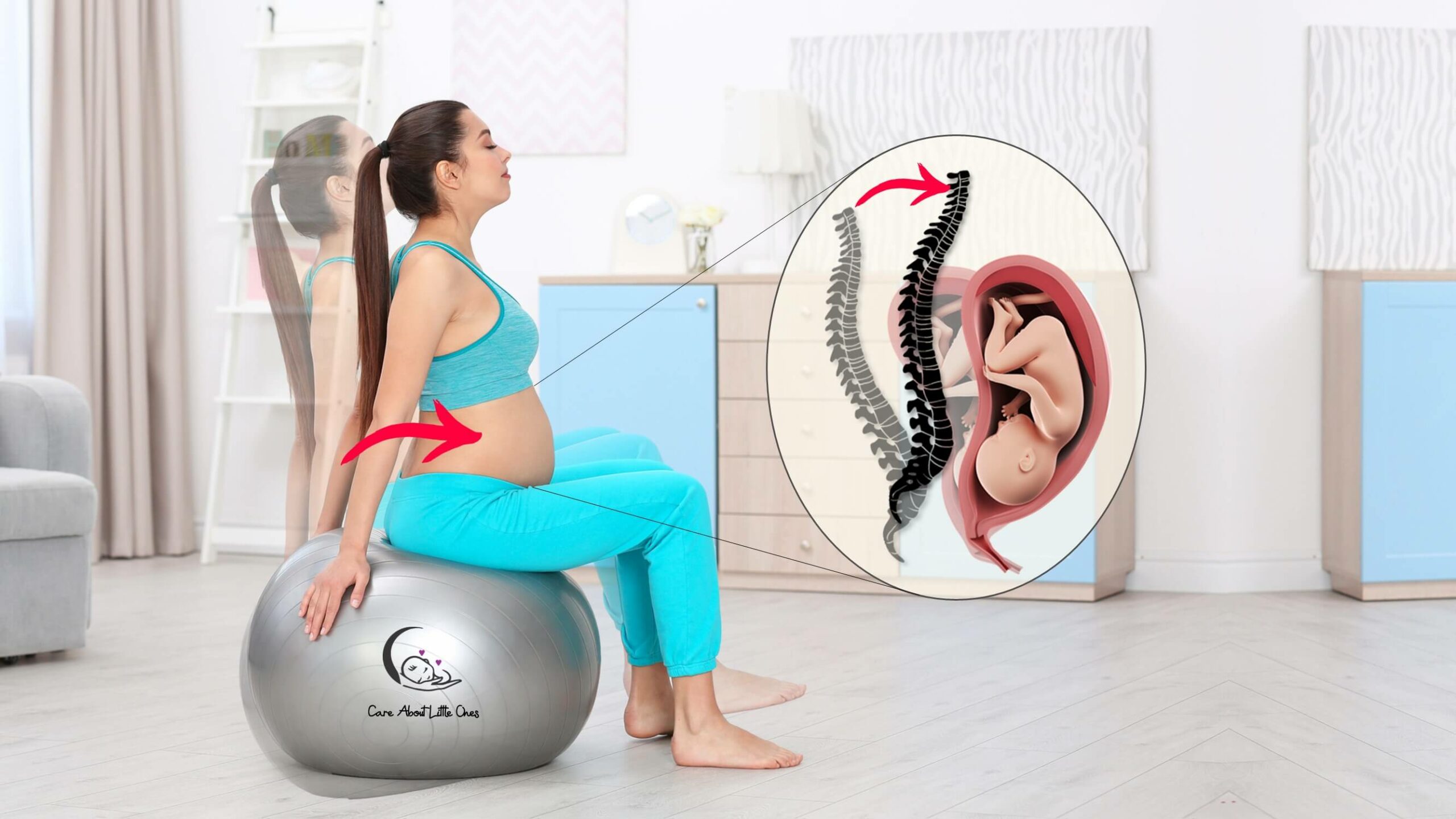
As they approach the end of their pregnancy, many moms-to-be start to worry. How should they help baby find a good position for labor? What about turning baby head down? What if baby is posterior? And how should I help baby engage in my pelvis?
So, how can you help your baby find a good position?
Most babies find a good position for labor all by themselves! The only problem is: moms-to-be often unintentionally do things that prevent a baby from doing so.
By adopting a good sitting position, you make sure that your baby has enough room in your womb to find a good position for labor. This cannot only increase baby’s chances to turn head down. It can also help baby rotate into an anterior position and engage in your pelvis.
In this blogpost, we first explain what “a good position for labor” means exactly. Then we explain how the way you sit affects baby’s ability to find a good position in the womb for labor.
And finally, we also discuss more “active” approaches to help baby find a good position, in case this sitting position alone does not help.
Table Of Contents
Why all that Fuss about Baby’s position in the Womb?
What does a “good Position for Labor” mean exactly?
What is the Advantage of an anterior Position?
Does a Baby “only” need to be head down and anterior?
So, how can you support your Baby find a better Position?
What are “bad” Sitting Positions?
So what is then the best Sitting Position?
How can I remain upright when I sit?
Why all that Fuss about Baby’s Position in the Womb?
If things were perfect during a delivery, your baby would simply move through your pelvis in one and the same position.
But where would be the fun in that?
To make a delivery a bit more challenging, nature decided that a pelvis should have some built-in “hurdles” for the baby.
To be precise, your pelvic inlet (i.e. the opening of your pelvis) has an oval shape that extends horizontally.
The center of your pelvis has a round shape.
And the bottom of your pelvis has an oval shape too. But that one extends vertically.
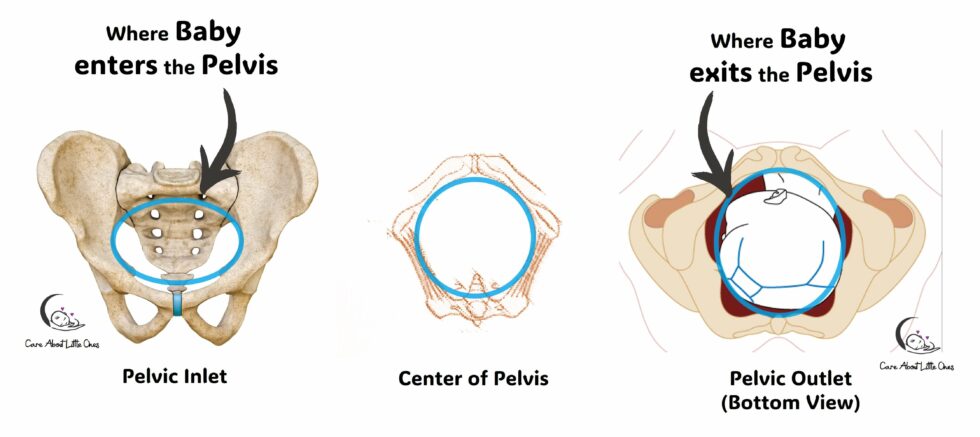
Because of those different “sections”, your baby cannot simply move from top to bottom in one and the same position.
In order to fit through each section of your pelvis, your baby needs to constantly adjust the position of baby’s head.
Why baby’s head?
Well, because it’s the biggest part of the baby.
Once baby’s head has moved through the pelvis, the rest is (normally) easy-peasy.
So, what then does baby’s overall position have to do with baby’s head?
Why not just focusing on baby’s head, instead of baby’s overall position?
Here is the problem:
The easier baby finds it to maneuver baby’s head through your pelvis, the smoother your delivery will normally go.
Just how easily a baby is able to adjust the position of baby’s head, depends on baby’s overall position in the womb.
As a result, the better baby’s position for labor, the smoother a delivery will normally go.
This does not mean at all that you cannot deliver a baby who is not in a good position.
Women do this every single day!
It just means that it is normally easier to deliver a baby who is in a good position for labor. Particularly if you are a first-time mom.
What does a “good Position for Labor” mean exactly?
Ideally, your baby is already in a “good position for labor” when entering your pelvis.
To be precise, we want baby to be head down (i.e. the head “ready” to enter the pelvis in a head-first position).
And ideally, we also want baby to face mommy’s back. This is called “anterior position” (as opposed to “posterior position”).
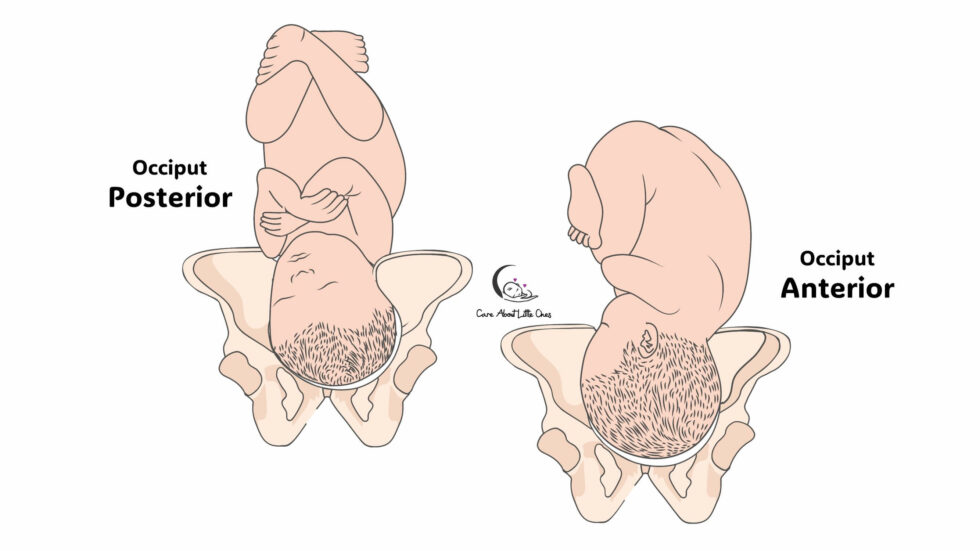
The words “anterior” and “posterior” refer to the back of baby’s head (the “occiput”). Accordingly, an anterior position means that the back of baby’s head is in the front (i.e. towards mommy’s tummy). In other words, baby faces mommy’s back.
While an anterior position is ideal, it is important to note that not all babies are anterior when labor starts.
A normal delivery is then (normally) still possible, particularly, because most babies rotate during labor into an anterior position.
Rotating into a better position during labor is possible. Just how easy it is depends on many factors. Such as:
- Whether or not this is your first delivery.
- The size of your baby.
- The size and shape of your pelvis.
- And other factors.
What is the Advantage of an anterior Position?
It has to do with the maneuverability of baby’s head that we mentioned earlier.
If baby faces your back, it is easier for baby to navigate baby’s head through your pelvis.
Here is an example:
When a baby exits the pelvis, baby uses the pubis symphysis as leverage.
But in order to do so, your baby’s neck needs to be where your pubis symphysis is. When that’s the case, your baby can then extend baby’s head. And by doing so, baby uses your pubis symphysis as leverage to exit the pelvis and your vagina.
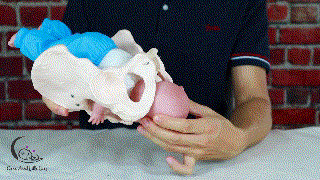
If, on the other hand, baby is occiput posterior, this is not possible. We hope you see why…
Does a Baby “only” need to be head down and anterior?
Actually, there is more to a “good position for labor” than just being head down and anterior!
In order to move through your pelvis, your baby has to enter your pelvis and engage in the first place. Engagement means that baby has reached a certain station in your pelvis relative to your ischial spines:

In order to have a normal delivery, a baby does need to engage in the pelvis at some point.
However, please keep in mind that not every baby engages before labor starts. Sometimes, babies only engage after contractions have started.
But as long as baby engages eventually, you can (normally) still have a normal delivery.
But back to baby’s position.
How easily a baby can enter the pelvis and engage depends again on baby’s position.
Both is easier, when your baby is in a position in which A) your baby’s body is well aligned with your pelvis. And B) Baby’s chin is tucked in.
We’ll have more to say about this when we talk about the best sitting position to help a baby find a good position for labor.
But here are two examples when the above does not apply, to help you understand what we mean:
Example 1:
In the image below, baby’s body is well aligned with the mother’s pelvis (lower white line). As you can see that woman is standing.
Now imagine what happens when that woman goes into a (semi-)reclined position!
The center of gravity of the baby’s body will shift (see blue arrow). And accordingly, the baby will no longer be well aligned with the pelvis.
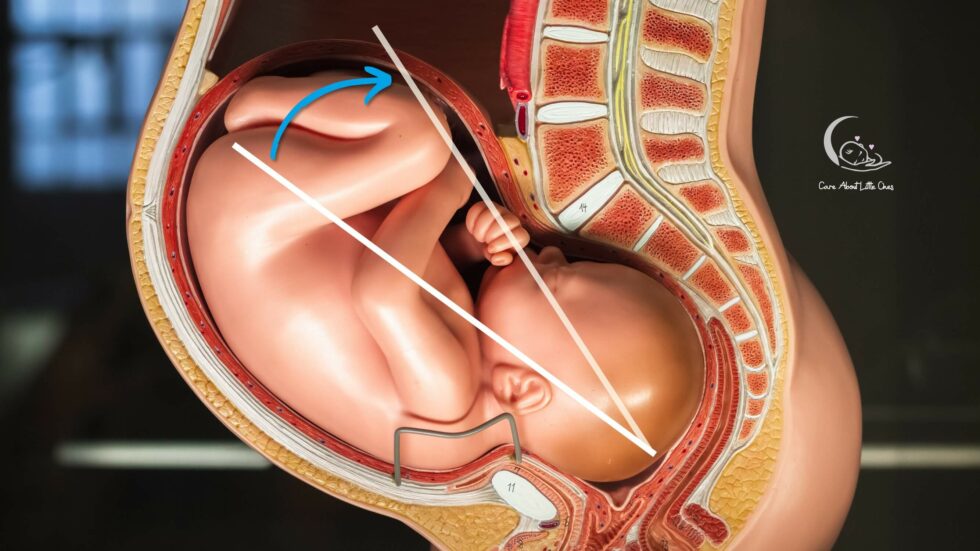
Example 2:
If your baby “looks upwards” from baby’s point of view, it is more difficult for baby to enter and engage in the pelvis. We need baby’s chin to be “tucked in”.
In both cases, we can help baby find a good position for labor.
So, to sumarize, a good position for labor means a head down presentation with an anterior occiput (i.e. baby facing your back). Baby’s chin is supposed to be tucked in. And baby’s body is supposed to be well-aligned with your pelvis.
Now, if – at this point – you throw your hands up in despair, let us share some good news:
Normally, babies do all of that all by themselves!
The only problem is that we often unintentionally prevent baby from finding a good position for labor. And you will understand why in just a second.
And the other thing is: it doesn’t hurt if we support the baby find a good position, does it?
So, how can you support your Baby find a better Position?
There are several ways to help baby find a good position for labor. But the most important way to support your baby is by adopting certain positions.
Why is that?
Well, as we said before, most babies will move into a good position for labor all by themselves. And they are more likely to do so, if you let them and if you support them.
By “if you let them”, we mean that you stop adopting positions that take away room from your baby in your womb.
And by “if you support them”, we mean that you adopt certain positions that provide your baby with more room.
In other words, if you provide baby with more room in your womb, you help baby find a good position for labor.
And one of the most important things to do, is avoiding “bad sitting positions” (“if you let them”) and adopting a good sitting position instead (“if you support them”).
Before we continue…
Did you know that your baby’s position also affects the changes your cervix will go through at the end of your pregnancy?
If your baby’s head is well-applied onto your cervix (which is normally the case when baby is in a good position), there is going to be more pressure on your cervix. And this can support the cervical changes at the end of your pregnancy.
However, that’s not the only factor that can support cervical changes.
In our free Cervix Preparation Guide, we show you how to prepare your cervix for labor during the weeks leading up to your expected due date!
A ripe cervix can increase your chances of a spontaneous start of labor and a normal delivery.
Download our guide >> HERE << for free!
What are bad Sitting Positions?
In order to understand what makes a good sitting position to help a baby find a good position in the womb, let us first explain what “bad sitting positions” are and what the problem is with those exactly.
Due do our modern lifestyle, we often adopt sitting positions that are super convenient. However, they are not necessarily optimal when you are pregnant.
Slouching on a sofa is the best example.
Whenever you are in a (semi-)reclined position, gravity presses your baby mostly against your spine.

In such a sitting position, it is more difficult for a baby to move into a better position.
(It’s still possible – just more difficult).
And it is also more difficult for baby to enter and to engage in your pelvis.
That’s because in such a position, your baby’s body is not well aligned with your pelvis. The center of gravity of your baby’s body is then simply too close to your own body.
Please note: this may not apply to all women!
If your abdominal muscle tone is pendulous, then it could actually be better for you to sit in a semi-reclined position. More about this in just a second!
What’s more is that many women make the effect of slouching positions unintentionally worse: they elevate their legs.
When you elevate your legs when you sit, you take away additional room in your womb.
The same applies when you sit in a car. It’s a semi-reclined position in which the level of your knees is higher than the level of your hips.
Again: less space for your baby to perform the desired action.
So, what then is the best Sitting Position?
First of all, whenever you sit, try to sit upright!! When you do this, the following happens:
Instead of pressing your baby and uterus mostly against your back, gravity now pulls your baby and uterus downwards. This causes your uterus to tilt slightly forward.
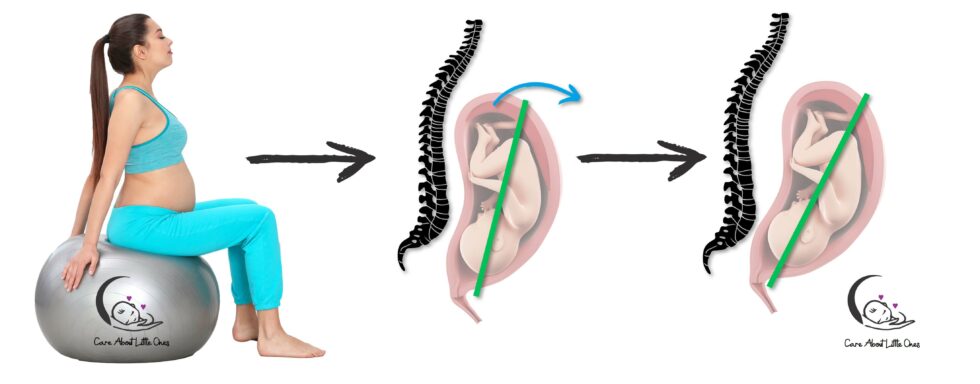
When that’s the case, your womb becomes like a hammock. And because of the resulting shift of the center of gravity of your baby’s body, your baby suddenly has much more room in your womb.
Second, you can increase the effect with the right position of your legs.
To be precise, you want to make sure that you don’t cross your legs! And you also want to make sure that the level of your knees is below the level of your hips!
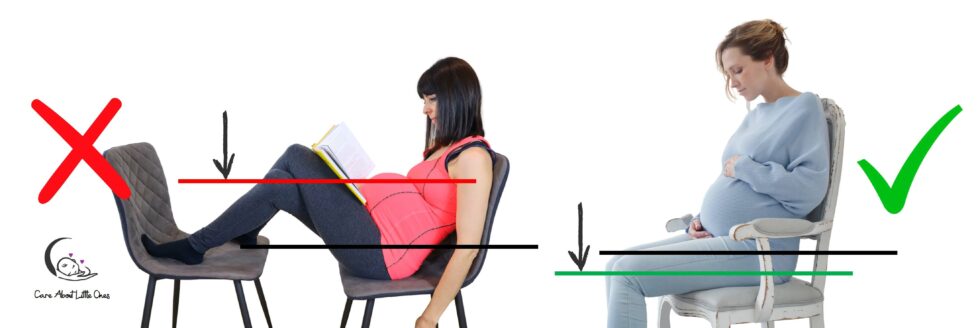
Please note: unlike the woman on the right in the image above, it is better to “open your legs” when you sit! It means additional room for your baby!
Third, unless your abdominal muscle tone is pendulous (see below), try to lean forward when you sit!
For this to work, your legs have to be in an open position!
That way, your uterus tilts even further forward. As a result, you further increase the “hammock-effect” and there will be even more room for your baby.
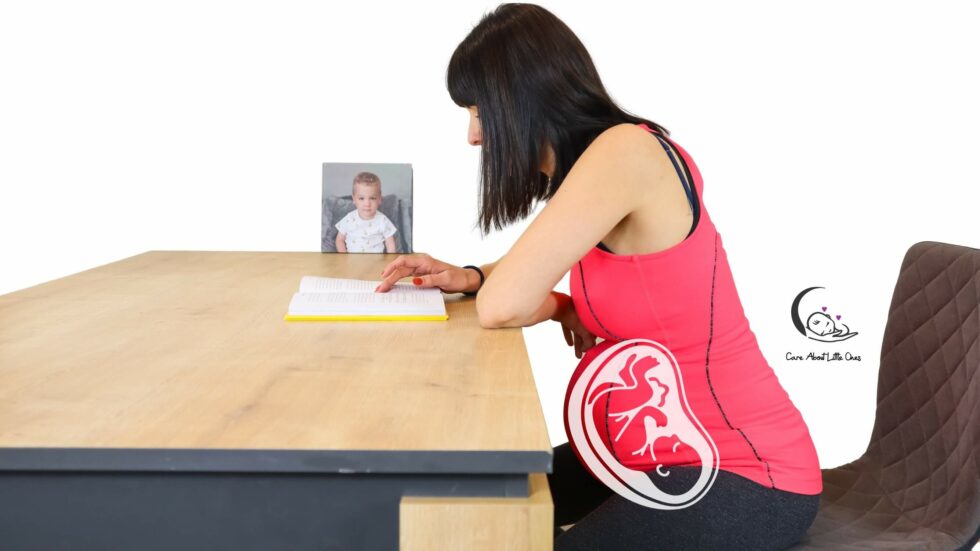
In such a sitting position, turning head down becomes much more doable. Even rotating from a posterior to an anterior position is easier in that case.
But what if your baby is already head down and anterior at that stage?
Well, even better! Because now, the center of gravity of your baby’s body is more forward. And because of that, your baby is normally better aligned with your pelvis.
So, you have basically changed the angle of your pelvis for your baby.
This in turn encourages flexion of baby’s head into your pelvis. And that way, it is easier for your baby to enter your pelvis, and, eventually, to engage.
What if your abdominal muscle tone is pendulous?
If your abdominal muscle tone is pendulous, then the problem is often that the center of gravity of your baby is too far forward when you sit upright. When that’s the caes, your baby’s body will not be well aligned with your pelvis when you sit upright.
In such cases, it can indeed be better to adopt a semi-reclined position! This will bring the center of gravity closer to your body which is normally better in such cases.
How can I remain upright when I sit?
It is not always so easy to remain upright when you sit.
In order to make it easier, many women use a wedge cushion.
A wedge cushion can help you keep your back upright and straight. It also makes you sit “higher” which helps you keep the level of your knees below the level of your hips.
This can be a particular help when you sit in a car!
Just please make sure that the cushion does not jeopardize your safety in the car!
What is the best time to do this?
Ideally, you start with this no later than week 35 (or week 33 if your baby is not head down yet).
And please also note: you don’t have to do this 24/7 to make it work!
We totally get that you are a tired and exhausted mommy! If you sometimes just feel like slouching on a sofa, legs up and everything…. By all means: do it!
What if my Baby does not move into a better Position?
As mentioned above, most babies move into a better position all by themselves.
Even more so, if you help baby find a good position with the tricks we have demonstrated in this blog post.
However, it’s important to note that even with more room in the womb, it is still up to your baby to “make a decision” to move into a better position for labor.
In other words: you basically open the door for your baby. But it’s up to your baby to “step through it”.
As we said before, in most cases, positions are enough to help baby find a good position for labor.
However, if your baby is stubborn (like some babies we personally now), then you might need a more “active” approach. For example, you might have to combine positions with exercises.
That way, you do not only “open the door” for your baby with positions. You also make your baby “step through it” with the help of exercises.
For example:
If you want your baby to engage in your pelvis, you could combine positions with deep squats.
That way, you do not only provide your baby with more room in your womb. In addition, deep squats help “press the baby” into your pelvis.
A similar strategy has helped us turn many babies head down. Though in that case, we combine positions with exercises and “moxibustion”. This is a TCM-based technique which we have applied very successfully to help pregnant women with all kinds of things.
So, if your baby is also a more stubborn one, here is what we normally do, depending on what you are trying to achieve:
How to turn a breech Baby (including transverse & frank breech)
Positions:
Try the sitting position from this blog post and the sleeping position from this blog post!
Exercises:
Research shows that, up to week 34, birth ball exercises can be very effective to encourage a baby to turn head down. We show you such exercises in this video on youtube!
If a baby is still breech (including transverse and frank breech) at 34 weeks, we have found that a combination of exercises and moxibustion can be very effective to turn a baby. We explain our approach in this video on youtube!
Please remember to always get the approval of your doctor first before you try anything that we mention! Thank you!
How to help an oblique head down Baby into a better Position
Positions:
Try the sitting position from this blog post and the sleeping position from this blog post!
Exercises:
Research shows that oblique presentations can (normally) easily be corrected with birth ball exercises. We show you such exercises in this video on youtube!
Please remember to always get the approval of your doctor first before you try anything that we mention! Thank you!
How to help a Baby rotate from a posterior into an anterior Position
You can help your baby rotate into an anterior position both before labor has started and after labor has started.
1 Before labor has started:
Positions:
Try the sitting position from this blog post and the sleeping position from this blog post!
Exercises and other things to try:
We recorded a video in which we show you several ways that could help you rotate baby into an anterior position. You can find this video here on youtube!
Please note: helping a baby rotate into an anterior position is not an easy task! We often observe that it seems to be easier to do this during labor because then, your contractions could help you.
2 After labor has started:
If your baby is still posterior after labor has started, there are several ways to help a baby rotate into an anterior position. We discuss this topic extensively in our birth preparation course (“natural, confident, science-based birthing”) and in our birth preparation bootcamp!
Please remember to always get the approval of your doctor first before you try anything that we mention! Thank you!
How to help a Baby engage in the Pelvis
Positions:
Try the sitting position from this blog post and the sleeping position from this blog post!
Exercises:
We have a protocol that we use at our practice to help a baby engage in the pelvis. We show you that protocol in this video on youtube!
Please remember to always get the approval of your doctor first before you try anything that we mention! Thank you!
How to help Baby tuck in Baby's Chin
Positions:
Try the sitting position from this blog post and the sleeping position from this blog post!
Exercises:
There is no resarch on which exercises could help a baby with that. However, we regularly observe that birth ball exercises seem to be very effective. We show you such exercises in this video on youtube!
Please remember to always get the approval of your doctor first before you try anything that we mention! Thank you!
What if my Baby still does not move into a better Position?
Alright listen!
No matter how hard we try, we too cannot bring every baby into the best position for labor for our clients.
Sometimes, there are circumstances which prevent a baby from finding a better position for labor. Such circumstances can be:
- The position of your placenta.
- The shape of your uterus.
- The amount of amniotic fluid.
- A very big baby.
- And other factors.
Obviously, these circumstances won’t disappear just because you adopt a good sitting position or do any exercises.
In other words, sometimes, there is just nothing you can do.
Please note that even when baby is not in a good position for labor, you can normally still have a normal delivery.
Normally, you could even have a normal delivery when your baby is breech. You would just have to find a doctor and hospital that support it which can sometimes be difficult (depending on where you live).
Don’t blame yourself!
In any case, if you have tried many different things but baby does not move into a better position for labor, then it is important that you don’t blame yourself!
It’s not that you haven’t tried hard enough!
Please always keep in mind that – at the end of the day – all that matters is that a healthy mother holds a healthy baby in her arms!
This is what we wish you too, with all of our hearts!
What else helps with a smoother and faster Delivery?
Helping baby find a good position for labor can obviously help you have a smoother and faster delivery. But there is more you can do!
Did you know that the way you breathe during labor has a direct effect on how smooth your delivery will go?
Well, that’s because if you do it the right way, it does not only help you relax. It also helps you keep your pelvic floor in motion! And that’s exactly what you need when your baby moves through your pelvic floor!
Because of that, in our free mini birthing course, we show you how to breathe and how not to breathe during labor.
We even use a device to prove to you that some breathing techniques are superior to others. And we show you how different techniques have different effects on your body during labor and thus on your delivery!
Plus: you also get a handout about breathing techniques that you can download!
👇👇👇
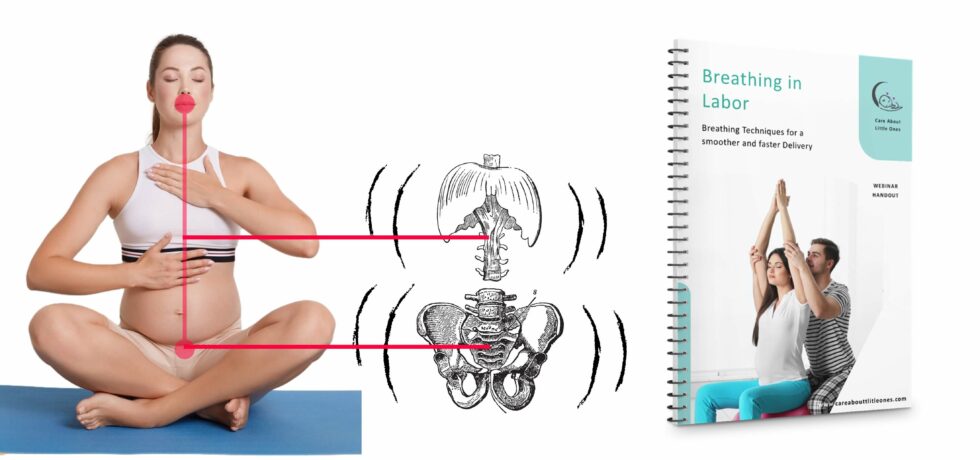
Click the button below to sign up for our free Mini Birthing Webinar!
Medical Disclaimer: The information on this page is not intended to diagnose, prevent, mitigate, treat or cure any disease! It is not personal medical advice. We recommend that you ask a doctor whenver you are looking for medical advice!
ABOUT THE AUTHORS
Nathalie Kaufmann & Mathias Ritter
Nathalie is a pregnancy and birth Consultant and a TCM Therapist with almost 20 years of experience in Traditional Chinese Medicine (TCM), acupuncture, reflexology, Shonishin baby massage techniques, Western and Eastern massage techniques (including TUINA), as well as herbal medicine and nutrition.
She has worked in hospitals across London and was Head of the Maternity Acupuncture Clinic at the Whittington hospital in London. Today, Nathalie runs her own practice in London and helps pregnant women with pregnancy- and birth-related issues. She also specializes in alternative treatments for babies and children.
Mathias is a Researcher and Science Geek who holds two Master of Science degrees. He has been involved in several health-related businesses over the past 10 years and has held presentations about health-related topics across Europe. He specializes in research regarding pregnancy-, birth and baby-related topics.
RELATED POSTS
How to increase the Oxygen Supply to the Baby in the Womb
During your pregnancy, there is a constant supply of oxygen to your baby. But what pregnant women often don’t know is that there are certain things that can reduce the oxygen supply to the baby. Luckily though, there are also very simple ways to increase the oxygen...
Pregnancy Vitamins: What Nutrients does a Fetus need & what Foods should I eat?
This blog post adds to our video on youtube in which we go through our list of the 9 most important micronutrients every fetus needs. If you have not watched our video so far, we recommend doing that first:Below, you can find a list of all the nutrients that we...
How to keep moving with an epidural
This blog posts adds to the video "8 reasons why labor can stall and what to do about it". In that video, among others, we explain the "roll-over technique from Penny Simkin (see sources below) which allows a woman to keep moving even when she is confined to bed....
How to keep track of Baby’s Movements
If your baby is active in your womb, then it is a sign that your baby is well. Because of that, most doctors recommend counting your baby's kicks from week 28 of your pregnancy onwards. In this brief blog post, we want to explain how you can keep track of your baby's...
How to relieve Pelvic Girdle Pain during Pregnancy
This blog post complements the information from our video on youtube on how to relieve pelvic girdle pain during pregnancy. In that video, we propose 2 ways to relieve pelvic girdle pain: 1. some minor changes in your lifestyle and 2. exercises. While the video...
Are you a good candidate for VBAC?
This blog post is intended to provide additional information apart from what we have mentioned in our video with the title "are you a good candidate for VBAC?" Moreover, on this page, you can find the entire list of scientific research studies which this video is...
The Purple Line – Find Out If You Are Dilating
The purple line can tell a woman if and how much she is dilated. So in this blogpost, we explain how to find out if you are dilating and how much you are approximately dilated.
How Effective Is Reflexology to Induce Labor?
Many women in their late pregnancy hope that reflexology can help them induce labor naturally. And indeed, reflexology is ONE of the tools that I apply to help women go into labor.So, how effective is reflexology to induce labor? Reflexology could help you induce...
Best Sleeping Position To Turn A Breech Baby (with Pictures)
Most babies turn at night. But unfortunately, not every sleeping position provides the baby with enough room to turn. As a result, many babies remain in a breech presentation. Luckily though, sleeping in the right position can support baby turn head down.So, what is...
LEAVE A REPLY



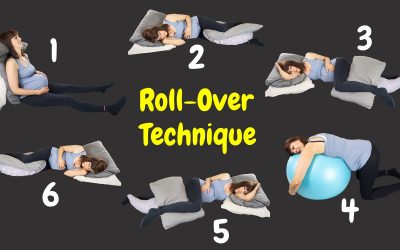



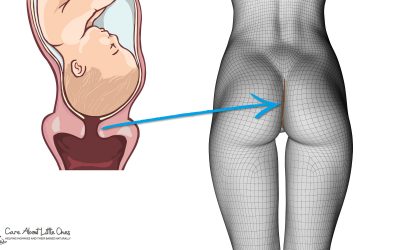


0 Comments